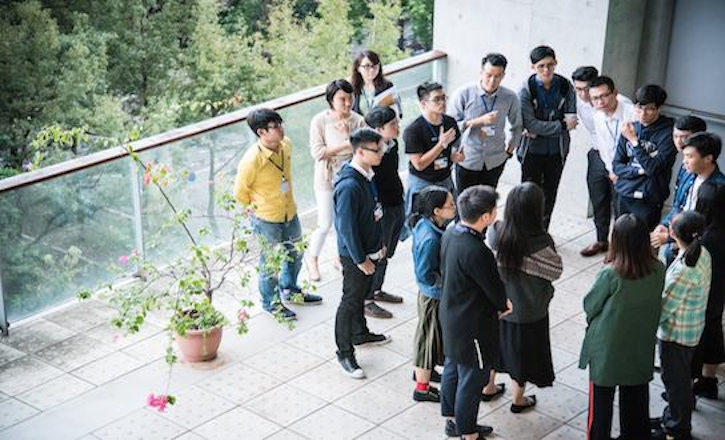
Ryan Chiu speaking with participants at Strait talk dialogue November 2017.
By Ryan Chiu, MS student
In March 2018, I will facilitate a workshop between Mainland Chinese, Taiwanese, and Hong Kong youth. This will not be the first time as I co-facilitated a similar event in April and November of 2017. A dialogue on cross-Taiwan Strait relations typically begins with the “one-China policy,” where participants determine what this concept means to them personally rather than having to choose between mainland China’s “one-China policy,” in which Taiwan is an inalienable part of China, or the U.S.’s “one-China policy,” in which said policy is acknowledged but not acted upon. In this sense, participants get to build upon, redefining, or even rejecting the policy as a whole.
Invariably, all cross-Strait youth programs start with participants guessing which Taiwanese participant is pro-independence (rejects the one-China concept and supports a new official name for the people and government on the island of Taiwan), which Taiwanese participant is pro-unification (agrees to the one-China principle but may either prefer the PRC government or the ROC government as the legitimate Chinese government), or which participant prefers the status quo. “Strait Talk” does not differ from this model, and could not even if the organizers or the facilitators tried. The independence or unification dilemma is indeed the current crux of the cross-Strait conflict, and it is the only point where people know how to start this discussion. However, this crux is only an issue of positions, and the concept of interests and needs are quickly introduced to move the discussion away from unsolvable dilemmas.
While working with youth at the start of the dialogue, we came to a consensus on how to interpret the current situation to help us move forward. This was achieved through an extensive amount of time working out the participants’ basic human needs (BHN) and what they perceived their respective communities’ basic needs were in relation to the cross-strait relations. Interwoven with these discussions of BHNs were activities and dialogues that encouraged empathy. A classic activity that was employed was the Walk through History. This involved each group discussing which historical events were key in shaping the Taiwan Strait Conflict. Participants then wrote the events onto large pieces of paper and laid them on the ground into three timelines for the three parties. From there, we walked through the listed history. Some events were the same across the parties, but most were not.
Participants were able to tell where the activity was headed the moment we asked each party to discuss events among themselves as sometimes a walk down the aisles of historical events can be somewhat overwhelming. On the superficial level, participants were excited to learn from other parties why particular events were chosen over others, but their conversations quickly moved away from the superficial level to examine which event led to a particular BHN. They then came to the realization that each party’s take on current cross-Strait relations is different due, not due to misinformation, but rather a long history of different events impacting the collective narrative of each region.
Finally, when we came to the consensus declaration drafting, the full understanding of the one-China concept came crashing upon the entire group at the workshop. The way around it was to reframe the one-China concept as the embodiment of several values that required attention. Once that had been done, the workshop transitioned into sessions in which participants proposed specific and concrete ideas on reconciling the differences in values, interests, and needs. Those ideas then served as the basis of the consensus declaration that included acknowledging the importance of preserving local cultures, proactively seeking to meet people’s needs in various forms, establishing other forms of communication outside of government channels, and redefining relations based on principle of equality, dignity, and respect. The empathy established earlier played a pivotal role in this phase when participants took into consideration others’ concerns and proactively modified proposals before even presenting them.
If there is a lesson to be learned from this entire experience, it is that given time and space, there is always a way for people to come together, work through seemingly intractable dilemmas, and come to an agreement, not just on current affairs, but also on ways to move forward. For me, the commitment to future peacebuilding work is built on this lesson taught by these experiences in Hong Kong and Taipei.
### More on the one-China principle/policy and the Taiwan Strait Conflict and coverage of the political situation in Hong Kong.
